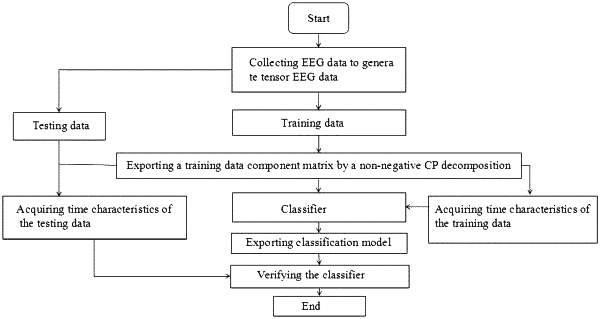| CPC A61B 5/374 (2021.01) [A61B 5/369 (2021.01); A61B 5/726 (2013.01); A61B 5/7267 (2013.01); G06N 20/00 (2019.01)] | 4 Claims |

|
1. An electroencephalogram (EEG) decoding method based on a non-negative CANDECOMP/PARAFAC (CP) decomposition model, wherein the method comprises the following steps of
step 1, acquiring frequency components of EEG data, constructing four-order tensor data including channel, frequency, time and test modes, dividing the four-order tensor data into a training set χtrain and a testing set χtest, calculating an average value χ of the training set χtrain, and decomposing χ to obtain three component matrixes χ=I×1A×2B×3C+E, wherein A∈
 c×m represents a channel component matrix, B∈ c×m represents a channel component matrix, B∈ f×m represents a frequency component matrix, C∈ f×m represents a frequency component matrix, C∈ t×m represents a time component matrix, I∈ t×m represents a time component matrix, I∈ m×m×m represents a unit cubic tensor, E∈ m×m×m represents a unit cubic tensor, E∈ m×m×m represents an error tensor, c represents a channel, f represents a frequency, t represents a time, and m represents a dimension of the unit cubic tensor; m×m×m represents an error tensor, c represents a channel, f represents a frequency, t represents a time, and m represents a dimension of the unit cubic tensor;step 2, based on interaction of modes of the tensor, extracting characteristics of the time components from χtrain and χtest by using a component matrix A and a component matrix B, which are expressed as:
 in a formula, ⊙ represents a Khatri-Rao multiple of a matrix, a superscript † represents pseudo inverse of the matrix, a subscript 3 represents a third mode of the tensor, Ctrain∈
 t×m×sr, Ctest∈ t×m×sr, Ctest∈ t×m×se, sr represent the number of training tests, and se represents the number of testing tests; t×m×se, sr represent the number of training tests, and se represents the number of testing tests;step 3, optimizing a characteristic dimension of the time component by adopting a two-dimensional principal component analysis (2-DPCA) algorithm; and comprising the following steps of
step 31: calculating a covariance matrix in Ctrain:
 calculating a characteristic value and a characteristic vector, and taking l characteristic vectors having a cumulative contribution rate of 0.97 of the characteristic value in the characteristic vector to form a column direction projection space P∈
 m×l, l<m, a column direction projection result is Ftrain,j=Ctrain,jP, Ftest,j=Ctest,jP; m×l, l<m, a column direction projection result is Ftrain,j=Ctrain,jP, Ftest,j=Ctest,jP;in the formula, Gt is a mean value of a sample covarianc matrix in Ctrain,
 is a mean value of a sample in Ctrain, sr represents the number of the training tests, t represents time, and m represents a dimension of a unit cubic tensor I;
step 32, calculating a covariance matrix in Ftrain:
 in the formula, Gt* is a mean value of a sample covariance matrix in Ftrain,
 is a mean value of the sample in Ftrain, sr represents the number of the training tests, t represents time, and m represents a dimension of the unit cubic tensor I;
step 33, evaluating the characteristic value and the characteristic vector of Gt*, and taking d characteristic vectors having a cumulative contribution rate of 0.97 of the characteristic value in the characteristic vector to form a row direction projection space V∈
 t×d, d<t; t×d, d<t;step 34, the obtained projection result is expressed as:
Qtrain,j=VTCtrain,jP, Qtest,j=VTCtest,jP;
in the formula, V is a projection space in a row direction, P is a projection space in a column direction, Ctrain,j is a single time component characteristic, Qtrain,j and Qtest,j are the characteristics of the optimized training data and testing data, respectively, and a superscript T represents a transposition of the matrix;
step 4, training a support vector machine with the training data to get a classification model, and then verifying classification performance of the model with the testing data to get the classification accuracy;
controlling movement of an external device according to the classification model's decoding result of EEG data of left and right hand movements.
|